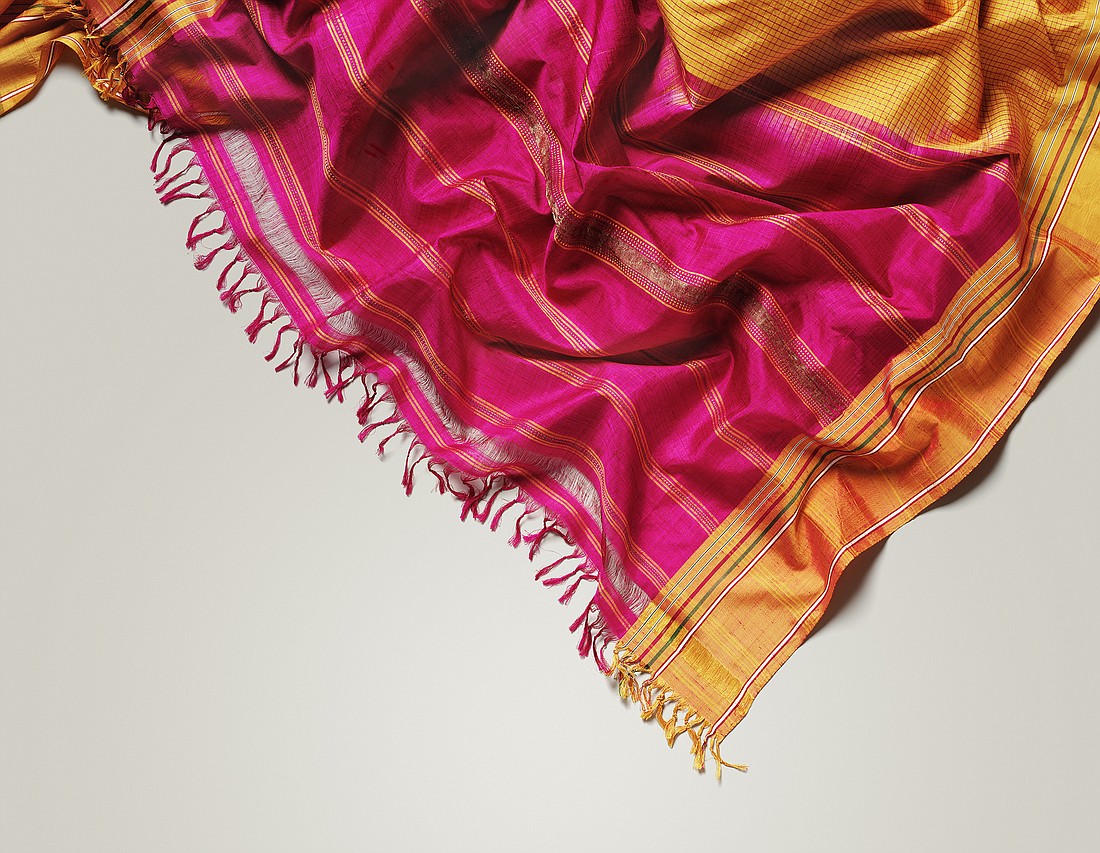- April 18, 2024
-
-
Loading

Loading

A walk through The Ringling’s Searing Gallery is a journey more than 500 years into the past — and more than 8,800 miles east.
“The Fabric of India,” The Ringling’s first major exhibit of Indian art, tells the story of the Indian materials and processes that changed the course of the global textile industry.
“If you wear clothing today, you should thank India for that,” says The Ringling’s curator for Asian art, Rhiannon Paget. “Our clothing, even fast fashion, has a lot of Indian DNA in it.”
The more than 140 objects comprising the show are dated between the 15th and 21st centuries and are on loan from the Victoria and Albert Museum in London. From modern saris to the hem of a skirt decorated with beetle wing cases, the variety of textiles is meant to showcase the various styles and materials used in Indian garment design.
But Curator of Asian Art at the V&A Avalon Fotheringham points out how there are several objects in the collection that aren’t wearable. The exhibit features a handful of ornate wall decorations, perhaps the most remarkable of which is a more-than-50-foot Gujarati room hanging that was discovered in 1994 on the streets of New York City after being thrown away outside a factory.
Looking at the massive artifact, which requires its own exhibit room, inspires one question: How did these items get here?
“Each of the pieces has its own individual crate built specifically for it,” Paget says. “Then each case is put into a big wooden crate — they’re very sturdy — that have gaskets to protect them from changes in climate and humidity and to stop bugs from getting in.”
The exhibit was last on view at the Cincinnati Art Museum, so once it ended in January, the items were packaged in said crates and delivered to The Ringling by truck. When they arrived, they were brought to the gallery space and unpacked by two conservators from the V&A (under the watchful eye of the curator).
“They watch to make sure it comes out of the crate the proper way,” Paget says. “[Then] we unpack the objects very carefully and condition-check them, which is done by one of the conservators and another member of our team as a scribe. If something has a lot of details, they might need three sets of eyes to look for any signs of deterioration.”
Paget says dealing with items that are several hundred years old means wear and tear isn’t surprising, but it’s important to inspect the objects meticulously in case you come upon old damages that weren’t previously recorded. (This is all required for insurance reasons.)
It took two V&A conservators 12 days to install the exhibit, and Paget predicts it will take just as long to take it down.
“Dressing a mannequin is an art itself,” she says. “It’s hard to dress a person, and this person doesn’t bend.”
Several garments in the exhibit are extremely heavy — particularly the wedding ensembles in the last of the exhibit’s six sections — which means those objects are at a higher risk of being damaged. The proper procedure is typically to detach the mannequin’s arms before sliding the garment on.
Paget says it often takes several people to place large mannequinless objects, such as the wall hangings. Most of these attach with the help of a bar screwed into the wall and a special connector stitched into the back of the object that she says we can thank NASA for making popular: Velcro.
“Museums are very democratic with our treatment of objects; everything gets treated with the same care,” Paget says. “So the silkworm cocoons and the little pieces of turmeric [fabric dye] — they are all protected from getting any contact with paint or the archival material we use to wrap them and stop them from reacting to any nasty chemicals.”
Another detail that can’t be overlooked in the installation process is lighting. Paget says light can deteriorate the textiles, dyes and pigments, so it’s highly controlled in the gallery space. The V&A specifies these light requirements along with humidity requirements, whether something has to be kept behind plexiglass and if it should be high up so nobody can touch or sneeze on it.
“Lots of gross things can happen to objects in museums,” she adds with a laugh.
“The Fabric of India” uses historical dress, fabric-making materials and current fashion designs to tell the social, economic and political story of India’s arguably most important good.
The six thematic sections of “The Fabric of India” use not only artifacts but also demonstrative videos to help explain different textile-making techniques — primarily weaving, dyeing, printing and embroidery. Visitors will also learn how India’s textile industry was affected by the industrial revolution, when suddenly the world didn’t care as much about hand-woven goods when they could have them mass-produced.
Paget says the exhibit tells the story of not just Indian textiles but also the shared global history of people and how they showcase their individuality.
“We wear clothing to express our identity,” she says. “Whether that’s religious or cultural or to show economic status or express political allegiances.”
She hopes that regardless of their personal style, visitors will leave the exhibit understanding the impact Indian textiles has made on the rest of the world.
“Jeans [originally] dyed with indigo — that indigo dye was really developed and made affordable through Indian production,” she says. “Cotton was domesticated and used in large quantities for the first time in India. You [have] benefited from the expertise and raw materials from India.”